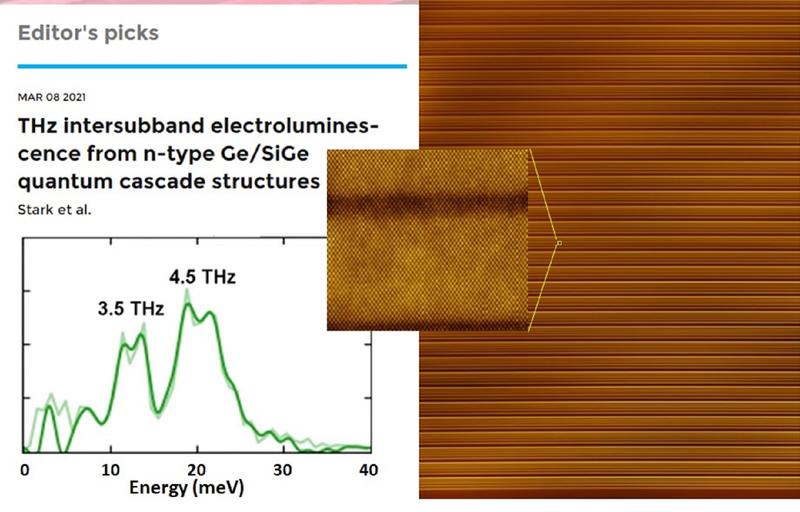Light from silicon
The demonstration of electroluminescence at terahertz frequencies from a silicon and germanium-based device represents a significant step towards the coveted milestone of a silicon-based laser.
An international team comprising scientists from Leibniz Institute for High Performance Microelectronics (IHP) has demonstrated for the first time THz light emission from n-type quantum structures made of germanium and silicon, the materials that are the basis of most commonly used electronic devices.
The result of demonstration was published in the Applied Physics Letters in the March 8 issue (D. Stark et al. “THz intersubband electroluminescence from n-type Ge/SiGe quantum cascade structures”, Applied Physics Letters 118, 101101 (2021), https://doi.org/10.1063/5.0041327), and was selected as "Editor's pick" by the editorial board of the important international journal. "This result represents the first credible step towards the realization of a new type of quantum cascade laser (QCL) for THz light emission, that could be entirely manufactured and which could be achieved at low cost using the manufacturing processes of common microelectronic devices," says Prof. Monica De Seta of the Science Department of Università Roma Tre, who coordinates the consortium of the European project FLASH (Horizon 2020 FET-Open project FLASH (G.A. 766719) https://www.flash-project.eu/). The FLASH consortium includes also the Zurich Polytechnic ETH (CH), the University of Glasgow (UK), the start-up NextNano of Munich (D), with the contribution of researchers from the La Sapienza University of Rome and University of Pisa (Ita).
THz light energy is between that of microwaves and infrared, and has peculiar characteristics, such as the ability to penetrate through many materials that are opaque in the visible range, such as paper and fabrics, is not ionizing and therefore do not damage living matter. Furthermore, the fact that many biological molecules and chemical compounds underlying complex materials such as explosives and drugs possess unique "fingerprints" in this spectral range, makes THz light extremely interesting from an application point of view.
“This important result has been made possible by the progress we have made in the ability to control the deposition of the quantum superstructures underlying the device. In practice, it was necessary to alternate hundreds of layers of different chemical composition, only a few billionths of a meter thick, with control at the level of the single atomic layer. Furthermore, we were able to reduce the defects that naturally forms in such thick structures. Both this achievements are crucial in obtaining the quantum cascade conditions that are necessary for the THz emission in our light emitting device "notes Prof. Giovanni Capellini, responsible for the materials characterization and leading the FLASH project at IHP.
The QCL device targeted by the FLASH consortium could represent a turning point in the use of THz technology on a large scale in various strategic sectors such as medical diagnostics, airport scanners, and in quality monitoring in industrial production. All these applications are in fact limited especially by the absence of compact and inexpensive THz light emitters.
Wissenschaftlicher Ansprechpartner:
Prof. Giovanni Capellini
Die semantisch ähnlichsten Pressemitteilungen im idw


